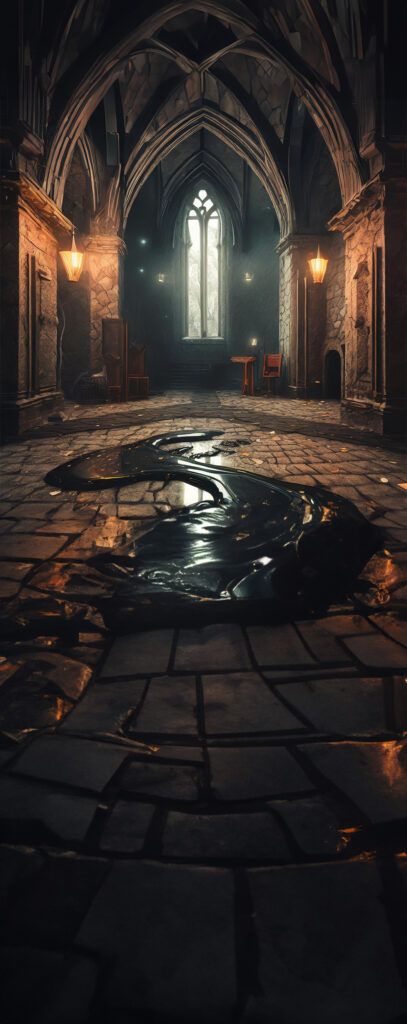Frequency: Uncommon
No. Appearing: 1-4 (1d4)
Armor Class: 7
Move: 20’
Hit Dice: 5d8 (22 hp)
% In Lair: 95%
Treasure Type: Nil
Attacks: 1
Damage: 1d6 Acid Damage + 1d6 Bludgeoning Damage
Special Attacks: Nil
Special Defenses: Immune to Acid, Poison
Magic Resistance: Standard
Intelligence: Low
Alignment: Neutral
Size: S to L (See Below)
Psionic Ability: Nil
Level/ X.P. Value: V / 150 + 6 per HP
 The Deathmire is a sinister and insidious creature that resembles a thin, oil-like substance that oozes and slithers across surfaces. It is a gelatinous mass that seems to blend in with darkness and shadows, making it difficult to detect until it’s too late. The slime emanates an aura of malevolence and decay, exuding an air of dread and unease that unnerves those who encounter it.
The Deathmire is a sinister and insidious creature that resembles a thin, oil-like substance that oozes and slithers across surfaces. It is a gelatinous mass that seems to blend in with darkness and shadows, making it difficult to detect until it’s too late. The slime emanates an aura of malevolence and decay, exuding an air of dread and unease that unnerves those who encounter it.The Deathmire appears as a viscous, amorphous entity that coats surfaces it comes into contact with. Its presence is marked by a dark, oily sheen, and it moves with a sinuous, flowing motion that allows it to spread and engulf its surroundings rapidly. The slime is almost translucent, giving it an eerie, ghostly appearance, especially in dimly-lit environments where its black coloration can be mistaken for shadows.
Special Abilities:
- Corrosive Touch: The Deathmire’s touch is corrosive and can rapidly break down organic matter and metal. Any creature or object that comes into contact with the slime risks being dissolved and consumed by its acidic properties.
- Melee Attack: Any creature or object that the Deathmire touches must succeed on a DC 12 Dexterity saving throw or take an additional 1d4 acid damage.
- Amorphous Form: The Deathmire can move through a space as narrow as 1 inch wide without squeezing, and it can enter and occupy the space of another creature.
- Envelop: The Deathmire can attempt to envelop a Medium or smaller creature in its space. The target must succeed on a DC 12 Dexterity saving throw or be engulfed by the slime. Engulfed creatures are blinded, restrained, and take 1d4 acid damage at the start of each of the Deathmire’s turns. A creature can use its action to make a DC 12 Strength check to escape. On a success, the creature exits the slime’s space.
- Split: When the Deathmire takes fire damage, it can split into two smaller Deathmire creatures, each with half the original’s current hit points (rounded down).
- Vulnerability to Fire: Like other gelatinous creatures, the Deathmire is vulnerable to fire. Exposure to flames or extreme heat can weaken and potentially destroy the slime, preventing it from replenishing its form or continuing its malevolent activities.
